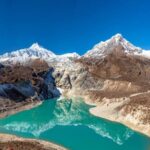If you’re like me, you’re fascinated by the stories that shape our world. One such tale is the water history of Camp Lejeune. Nestled in North Carolina, this military base has a water saga that’s as intriguing as it is alarming.
From the 1950s to the 1980s, the base’s water supply was contaminated with harmful chemicals. It’s a dark chapter in the camp’s history that has had far-reaching effects. The health impact on service members and their families is a chilling reminder of the importance of clean water.
In this article, we’ll dive deeper into Camp Lejeune’s water history. We’ll explore the causes of the contamination, the aftermath, and the ongoing quest for justice by those affected. Stay tuned as we unravel this complex narrative.
Background of Camp Lejeune
Established in the early 1940s, Camp Lejeune has long been a crucial military base located in Jacksonville, North Carolina. Over the course of its existence, this base has trained hundreds of thousands of service members ranging from infantry to specialized combat training.
During the 1950s up until the 1980s, the base was unknowingly contaminating its water supply. This happened due to improper disposal of industrial solvents, most notably trichloroethylene (TCE) and perchloroethylene (PCE), both highly toxic and carcinogenic substances. It was later revealed that these dangerous chemicals seeped into the groundwater, eventually tainting the base’s water supply.
At its peak, Camp Lejeune housed nearly 170,000 residents. The extent of the water contamination was such that it put almost the entire population of the base at risk. The men, women, and children living at the base ingested the contaminated water unknowingly for nearly three decades. It’s estimated that nearly one million people could have been affected when considering the constant flow of marines, their families, and civilian workers.
Frighteningly, it wasn’t until 1982 that the contamination was discovered. Even more shocking, it took until 1989 for the contaminated wells to be completely shut down. Despite the discovery of the contamination and its potential health impacts, there wasn’t immediate action to address the issue.
Our journey now takes us further into the heart-wrenching history of this catastrophe. As we delve deeper into this, we’ll uncover the many layers of hardship faced by those at Camp Lejeune, the fight for justice, and the longer-term impacts on their health.
Water Contamination Discovery
It wasn’t until the early 1980s that Camp Lejeune’s water contamination issues came to light. The startling revelation occurred during a routine site inspection conducted by the base’s environmental department in 1982. The inspection team uncovered volatile organic compounds (VOCs) like trichloroethylene (TCE) and perchloroethylene (PCE), alarmingly high and way above the Total Maximum Daily Load (TMDL)—industry standards set for safe drinking water.
Despite discovering the contamination, it took until 1985 for extensive groundwater studies to be commissioned. These studies were a necessity to comprehend the extent and impact of the contamination. Concentration levels of VOCs recorded were staggeringly high. In comparison with the allowed TMDL, TCE concentrations were 280 times higher, while PCE concentrations were 3,400 times higher.
| Compound | Observed Concentration | TMDL | Times above TMDL |
|---|---|---|---|
| TCE | 1400 ppb | 5 ppb | 280 |
| PCE | 17000 ppb | 5 ppb | 3400 |
Steps to remedy taken in 1985 resulted in shutting down all tainted water treatment plants, but unfortunately, definitive actions to fully address the contamination and its consequences took longer than necessary. The delay in response further exacerbated the health risks for the base’s residents.
Unbeknown to me and the rest of the Camp’s residents, the environmental debacle spanned decades. From contamination during the ’50s to its eventual discovery in the ’80s, it was a ticking time bomb. Its profound health impacts continue to raise grave concerns for marines, their families, and civilian workers who unwittingly consumed the contaminated water.
A concerted effort towards understanding all aspects of this crisis is crucial to learning from past failures. It’s our responsibility as a society to ensure that such catastrophes do not repeat, safeguarding public health and the environment simultaneously.
Health Impact on Service Members and Families
The revelation of contaminated water at Camp Lejeune created a wave of concern across the country, primarily focusing on the health impacts felt by service members and their families. The residents’ prolonged exposure to the contaminated water, laden with toxic chemicals far beyond safe drinking standards, resulted in severe health repercussions.
Believe it or not, the water crisis at Camp Lejeune was deemed one of the largest water contamination cases in American history. This contamination led to a slew of health problems among residents. Some of these health issues took years, even decades, to surface, yet their roots can be traced back to the-base contamination.
One can’t deny that Marines, their families, and civilian workers stationed on-base were the frontline victims. Hundreds of thousands were silently battling the after-effects of toxic water exposure. The initial response from authorities didn’t happen until 1985, indicating a period of years of lingering toxicity without remedial action.
Let’s delve into the type of health problems residents experienced. The toxic chemicals led to a variety of ailments including but not limited to:
-
- Kidney cancer
-
- Adult leukemia
-
- Liver cancer
-
- Non-Hodgkin’s lymphoma
-
- Parkinson’s disease
These diseases were, in essence, brewing silently within. Many residents discovered their conditions much later. There’s a wide consensus among experts that these adverse health effects could be directly linked to the exposure to drinking and using the contaminated groundwater.
Given the magnitude and severity of the health issues, it’s vital to shed light upon individual stories, voices of those who endured this crisis, amplifying their experiences. Understanding their fight for justice and health is key to avoiding such scenarios in the future. There is no denying that the damage inflicted has left a deep mark on the lives of many, a reality that continues to echo even today.
Cleanup Efforts and Legal Battles
As we traverse the timeline of the Camp Lejeune water saga, significant events marked the course of action, starting with cleanup efforts progressing to lengthy legal battles. The initiation for cleanup at the camp only began in 1989, four years after the contaminated wells were shut down. The primary concern here was the removal of harmful chemicals such as trichloroethylene (TCE) and perchloroethylene (PCE), notorious for their numerous health risks. The process was slow, tedious, and costly, given the scale of contamination.
Whilst these endeavors progressed, victims of the water crisis were rallying for justice. Thus, began the wave of legal battles. It’s vital to underline that the victims were families, service members – the very people dedicated to protecting the state. As their health suffered, the least they deserved was recognition and compensation.
-
- In 1997, the Agency for Toxic Substances and Disease Registry (ATSDR) conducted studies on the birth outcomes and infant mortality at Camp Lejeune.
-
- A settlement was reached in 2012 with Jerry Ensminger, a retired Marine Master Sergeant, marking the first victory for victims.
-
- In 2014, President Obama signed the Honoring America’s Veterans and Caring for Camp Lejeune Families Act into law. The law stipulates that the VA provide medical care to veterans and their families who developed one or more of the 15 health conditions associated with long-term exposure to TCE or PCE.
| Year | Event |
|---|---|
| 1989 | Cleanup Initiatives Begin |
| 1997 | ATSDR Study |
| 2012 | Jerry Ensminger Settlement |
| 2014 | VA Care Law Signed |
These steps marked progress, albeit slow and often frustrating. Justice weaved its way through the courts, with sufferers forced to display an unimaginable level of patience and resilience. As the battle for accountability continued, the cleanup efforts at the camp pressed onward, indicative of a silent promise to prevent the recurrence of such a disaster.
Ongoing Advocacy and Seeking Justice
Stepping into the late 90s and early 2000s, as my story continues, noteworthy advocacy took center stage. Several proactive measures were embraced by a committed community, progressing towards achieving justice.
Witnessing the determination of individuals affected by the contamination, I was moved. In their quest for justice, they’ve had to grapple with not just health challenges but also legal hurdles. As an integral part of society, it’s crucial to remember these unsung warriors who continued to push for recognition and remediation despite all odds.
Public interest in the Camp Lejeune crisis was reinvigorated – thanks to the relentless advocacy efforts. Broadly implying a positive stride, two main legal milestones were accomplished, breaking the ice – the 2012 civil lawsuit settlement and the historic VA (Veterans Affairs) Care Law signed into action in 2014.
The 2012 Settlement
The year 2012 marked a significant victory for victims when a settlement concerning Camp Lejeune was reached. Though not all victims came under the umbrella of this settlement, it undeniably marked a turning point in the ongoing battle.
Note the key facts about the 2012 settlement in the table below:
| Key Fact | Description |
|---|---|
| Settlement amount | Unspecified |
| Coverage | Limited number of victims |
| Legal ramification | Set a precedent |
Veterans Affairs Care Law, 2014
Further evolution in the justice journey happened two years later. The VA Care Law enactment in 2014 demonstrated a glint of hope for many affected heroes. It extended benefits and assured healthcare coverage to affected veterans, ensuring they weren’t financially saddled by the after-effects of the contamination.
In the table below, I’ve detailed the key aspects of the VA Care Law (2014):
| Key Fact | Description |
|---|---|
| Provisions | Health benefits and coverage |
| Target group | Affected veterans |
| Legal ramification | Extended support and financial alleviation |
Remember, the quest for justice is ongoing. The pledge to bring the culprits to book and ensure holistic healing for the victims of the Camp Lejeune water contamination continues. And as we delve deeper into this journey, we discover the potent power of resilience, patience, and unwavering commitment.






